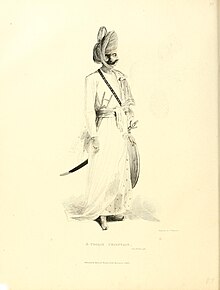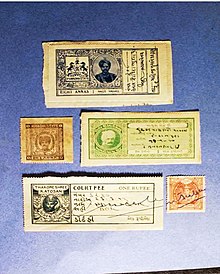Many parts of Western and Northern regions of the Indian subcontinent were ruled as sovereign or princely states by various clans of Kolis.

Principalities and clans
[edit]

- Koli of Saurashtra[1]
- Kolis of Dadra and Nagar Haveli[2][3]
- Mukne Dynasty of Jawhar State[4]
- Bhangare of Devgaon[5]
- Shah of Ramnagar Kingdom[6]
- Raja of Peint[7]
- Pawar Dynasty of Surgana State[8]
- Negi of Koligarh[9]
- Mer of Dhandhuka[10]
- Thorat of Daman and Diu[11]
- Patil of Janjira[12]
- Patil of Guhagar[13]
- Nayak of Sinhagad[14]
- Kagadia of Umrala[15]
- Mahawar of Khadipdesh
- Chief of Sindkhed[16]
- Sord dynasty of Idar State[17]
See also
[edit]References
[edit]- ^ Tarlo, Emma (1996). Clothing Matters: Dress and Identity in India. New Delhi, India: C. Hurst & Co. Publishers. p. 138. ISBN 978-1-85065-176-5.
- ^ Bhatt, Shankarlal C. (2006). Land and People of Indian States and Union Territories: In 36 Volumes. Dadra and Nagar Haveli. New Delhi, India, Asia: Gyan Publishing House. p. 17. ISBN 978-81-7835-388-3.
- ^ "About UT Administration | UT of Dadra and Nagar Haveli and Daman and Diu | India". Retrieved 2024-06-11.
- ^ "Trove of tribal treasures". Deccan Herald. 2019-06-15. Retrieved 2021-01-31.
- ^ Hardiman, David (2007). Histories for the Subordinated. New Delhi, India: Seagull Books. p. 104. ISBN 978-1-905422-38-8.
- ^ Sarkar, Jadunath (1992). Shivaji and His Times. Orient Longman. p. 145. ISBN 978-81-250-1347-1.
- ^ Deshpande, Arvind M. (1987). John Briggs in Maharashtra: A Study of District Administration Under Early British Rule. Mittal Publications.
- ^ Waghmare, Abhishek (2018-04-14). "Why Maharashtra farmers walked 170 km and how their strike played out". Business Standard India. Retrieved 2021-01-31.
- ^ Negī, Kuṃvarasiṃha (2001). Gaṛhavāla Maṇḍala kī jānī mānī divaṅgata vibhūtiyam̐ (in Hindi). Kuṃvara Siṃha Negī "Karmaṭha".
- ^ Pfeffer, Georg; Behera, Deepak Kumar (1997). Contemporary Society: Concept of tribal society. Concept Publishing Company. ISBN 978-81-7022-983-4.
- ^ Verma, Balraj (2006). The Beautiful India - Daman & Diu. Reference Press. p. 10. ISBN 978-81-8405-022-6.
- ^ Yimene, Ababu Minda (2004). An African Indian Community in Hyderabad: Siddi Identity, Its Maintenance and Change. Cuvillier Verlag. ISBN 978-3-86537-206-2.
- ^ Cāpekara, Nārāyaṇa Govinda (1966). Citpāvana (in Marathi). p. 25.
- ^ Desāī, Rameśa (1987). Shivaji, the Last Great Fort Architect. Maharashtra Information Centre, Directorate-General of Information and Public Relations, Government of Maharashtra. p. 68.
- ^ Roy, Dr. Shivani (1983). Koli culture: a profile of culture of talpad vistar. 24-B, Ansari Road, Daryaganj, New Delhi 110002: Cosmo publications. p. 78.
((cite book)): CS1 maint: location (link) - ^ Shrivastavya, Vidayanand Swami (1952). Are Rajput-Maratha Marriages Morganatic?. New Delhi, India, Asia: D.K. Shrivastavya. pp. 249: The Koli chief of Shindkhed who being entangled in feud, was in need of warriors. On hearing of the encampment of the Jadav brothers in the city, he visent his emssary to.
- ^ Imperial and Asiatic Quarterly Review and Oriental and Colonial Record. New Delhi, India, Asia. 1968. pp. 147: About A.D. 1300, they captured Idar State from its Koli chief of the Sord clan, whom the Ráthor cut down in the gate . Dying, he marked with his blood the royal " tilak " on the forehead of the victor, and begged that whenever a.
((cite book)): CS1 maint: location missing publisher (link)